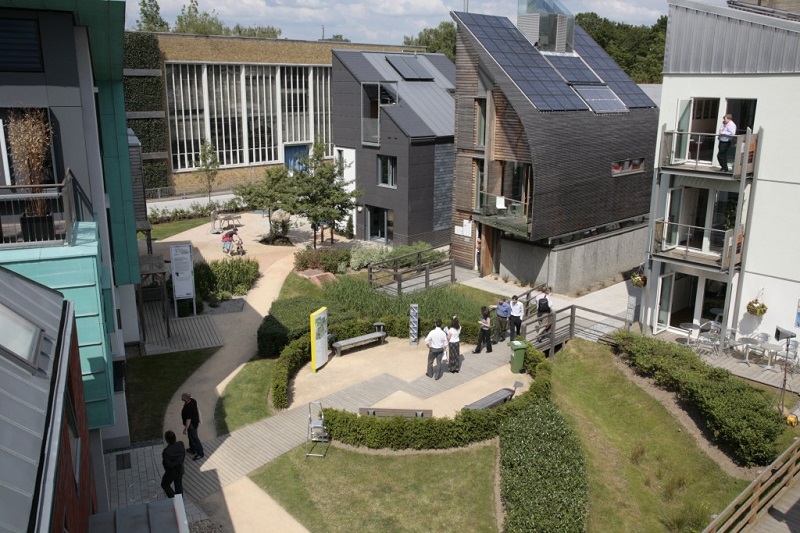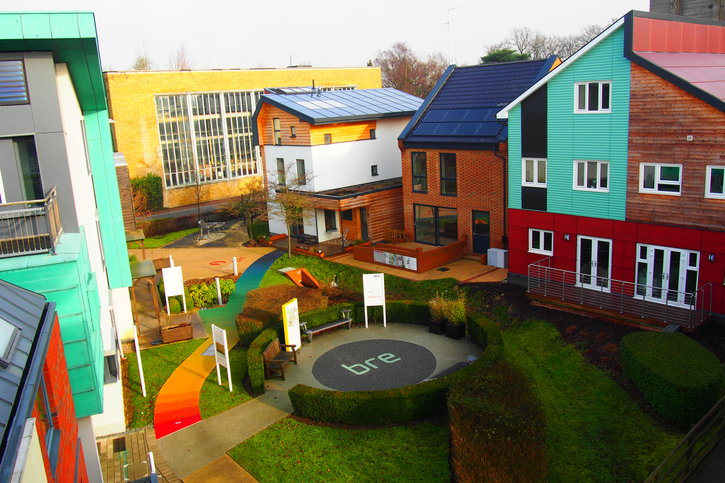BRE Watford Innovation Park
Contents |
[edit] Introduction
The BRE Watford Innovation Park is the flagship development of an international network of innovation parks, established to inform sustainable research and innovation within the built environment.
Despite other Innovation Parks having subsequently been established in Scotland, China, as well as being under-development in Brazil and Canada, the park in Watford, at BRE’s headquarters, remains one of the premier research facilities of its kind in the world.
Since its launch in 2005, as a small-scale demonstration of modern methods of construction (MMC), the Park has welcomed more than 100,000 visitors on its guided tours of the facilities. A tour includes self-guided audio of the Park and testing facilities, and group bookings can be arranged. BRE also run technical tours which are led by an expert guide.
Whether you are a professional, student or just an interested member of the public, the facilities are well-worth taking the time to explore as a means of gaining an understanding of the pioneering and vital work that BRE do.
Designing Buildings Wiki went along to the September 2017 Open Day, celebrating the 20th anniversary of the BRE Trust, to explore the site.
[edit] Testing facilities
BRE officially opened a brand-new acoustics laboratory in time for the anniversary celebrations – a state-of-the-art test facility for assessing the ability of products, such as floor or wall panels, to prevent the transmission of sound between rooms. It also contains a plug panel system for the less labour-intensive testing of smaller products such as doors and windows.
This is in addition to another brand new anechoic chamber, a completely silent and echo-free sound testing space used for a range of acoustic tests, such as assessment of the performance of fire alarm sounders.
The other testing facilities include:
[edit] Structural test hall
A large-scale test laboratory for structures up to 4 storeys high and subject to loads of up to 2,500 tonnes.
[edit] Burn Hall
A large-scale indoor fire test facility for a range of standards and regulatory testing.
[edit] Timber library
A unique Xylarium displaying 30,000 timber specimens.
[edit] Flood resilient house
As seen on BBC’s ‘Countryfile’, this home showcases a range of possible systems to prevent houses flooding and to allow houses to be reoccupied quickly following a flood.
For more information, see Flood resilient house.
[edit] Landscaping
But it’s not only the demonstration buildings that provoke interest; the landscaping has been carefully designed to feature a variety of SUDS products, green roofs, a swale, permeable blocks, resin paving systems and biodiversity innovations.
History buffs may also be excited by the Park’s scale model of the Mohne Dam which was built in secret in late-1940 and used in the very initial experiments that led Barnes Wallis to develop the Dambusters’ famous bouncing bomb.
[edit] Innovation Park
Central to the site though is the Innovation Park itself, which acts as a ‘demonstration village’ showcasing innovations in construction, energy efficiency, and sustainable landscape.
Some of the buildings that can be explored as part of a tour include:
[edit] Barratt Green House
This was the winner of the Mail on Sunday’s 2007 Home for the Future design competition. Created with urban living in mind, it was the first home by a mainstream housebuilder designed to Level 6 of the Code for Sustainable Homes.
[edit] Hanson EcoHouse
This was the first masonry house designed to Level 4 of the Code for Sustainable Homes. It addresses the combined challenges of off-site construction and climate change.
[edit] The Prince’s Natural House
Built in 2012, this house demonstrates a simple, low-tech and easy-to-build alternative for volume housebuilders seeking to meet increasingly stringent low carbon targets for new homes.
[edit] Renewable House
This house aims to demonstrate the practicality and affordability of whole life sustainability for modern housing. It was built in 2009 by the National Non-Food Crops Centre (NNFCC) with renewable low carbon materials such as wool and hemp.
[edit] Sigma Home
Comprising two units, one complete and one left unfinished to reveal its innovative features, the Sigma Home was the first house in the UK designed to Level 5 of the Code for Sustainable Homes. A local family occupancy tested it for two weeks each season over the course of a year, with the findings used for future home designs from the Stewart Milne Group.
[edit] Related articles on Designing Buildings Wiki
- BRE articles on Designing Buildings Wiki.
- ACM cladding testing by BRE.
- BRE Trust.
- BRE Üserhuus.
- Building Research Establishment (BRE).
- Dementia-friendly home.
- Design for deconstruction, BRE modular show house.
- Flood resilient house.
- Qualitative research and the built environment.
- The Biophilic Office.
- Zero Bills Home.
Featured articles and news
Infrastructure that connect the physical and digital domains.
Harnessing robotics and AI in challenging environments
The key to nuclear decommissioning and fusion engineering.
BSRIA announces Lisa Ashworth as new CEO
Tasked with furthering BSRIA’s impressive growth ambitions.
Public buildings get half a million energy efficiency boost
£557 million to switch to cleaner heating and save on energy.
CIOB launches pre-election manifesto
Outlining potential future policies for the next government.
Grenfell Tower Inquiry announcement
Phase 2 hearings come to a close and the final report due in September.
Progress from Parts L, F and O: A whitepaper, one year on.
A replicated study to understand the opinion of practitioners.
ECA announces new president 2024
Electrical engineer and business leader Stuart Smith.
A distinct type of countryside that should be celebrated.
Should Part O be extended to existing buildings?
EAC brands heatwave adaptation a missed opportunity.
Definition of Statutory in workplace and facilities management
Established by IWFM, BESA, CIBSE and BSRIA.
Tackling the transition from traditional heating systems
59% lack the necessary information and confidence to switch.
The general election and the construction industry
As PM, Rishi Sunak announces July 4 date for an election.
Eco apprenticeships continue help grow green workforce
A year after being recognised at the King's coronation.
Permitted development rights for agricultural buildings
The changes coming into effect as of May 21, 2024.























